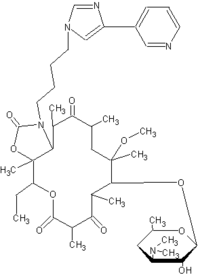Ketek
Telithromycin is the first ketolide antibiotic to enter clinical use. It is used to treat mild to moderate respiratory infections. Telithromycin is sold under the brand name of Ketek. more...
Telithromycin is a semi-synthetic erythromycin derivative. It is created by substituting the cladinose sugar with a ketogroup and adding a carbamate ring in the lactone ring. An alkyl-aryl moiety is attached to this carbamate ring. Furthermore, the carbon at position 6 has been methylated, like in clarithromycin, to achieve better acid-stability.
History
French pharmaceutical company Hoechst Marion Roussel (later Aventis) started phase II/III trials of telithromycin (HMR-3647) in 1998. Telithromycin was approved by the European Commission in July 2001 and subsequently came on sale in October 2001. In USA, telithromycin gained FDA approval April 1, 2004 .
Available forms
Telithromycin is administered as tablets. Two 400mg tablets to be taken together, daily, with or without food.
Mechanism of action
Telithromycin prevents bacteria from growing, by interfering with their protein synthesis. Telithromycin binds to the subunit 50S of the bacterial ribosome, and thus inhibits the translocation of peptides. Telithromycin has over 10 times higher affinity to the subunit 50S than erythromycin. In addition, telithromycin binds simultaneously in to two domains of 23S RNA of the ribosomal subunit 50S, where older macrolides bind only in one. Telithromycin can also inhibit the formation of ribosomal subunits 50S and 30S.
Pharmacokinetics
Unlike erythromycin, telithromycin is acid-stable and can therefore be taken orally without being protected from gastric acids. It is fairly rapidly absorbed, and diffused into most tissues and phagocytes. Due to the high concentration in phagocytes, telithromycin is actively transported to the site of infection. During active phagocytosis, large concentrations of telithromycin is released. The concentration of telithromycin in the tissues much higher than in plasma.
Metabolism
It is metabolized mainly in the liver, the main elimination route being the bile, a small portion is also excreted into the urine. About one third is excreted unchanged into the bile and urine, the biliary route being favoured. Telithromycin's half-life is approximately 10 hours.so
Side effects
Most common side-effects are gastrointestinal; diarrhoea, nausea, abdominal pain and vomiting. Headache and disturbances in taste also occur. Less common side-effects include palpitations, blurred vision and rashes.
Rare, but severe side effects reported in January 2006 involve damage to the liver. Three different incidents reported, one ending in death, one in a liver transplant and one case of drug induced hepatitis.
Has been known to cause false positive readings in drug screenings for cocaine and amphetamines.
Read more at Wikipedia.org



